
Resolution: Wholly Whole Grains
Author: be well™ with Big Y® Registered Dietitian Team
When you think of whole grains, what kinds of food or flavors come to mind? Brown rice, whole wheat bread, quinoa, whole grain mini-pita, wild rice, oatmeal, ready-to-eat cereal and popcorn are just a few of the delicious whole grain foods available on our shelves now.
Working toward incorporating more whole grains in your meals won’t only impact your health in 2023, it very well could change your taste buds…and for the better. Try it out for yourself! Once you become accustomed to breads, pasta and baked goods with heartier texture and fuller flavor, it’s hard to go back.
Why You Should Choose Whole Grains.
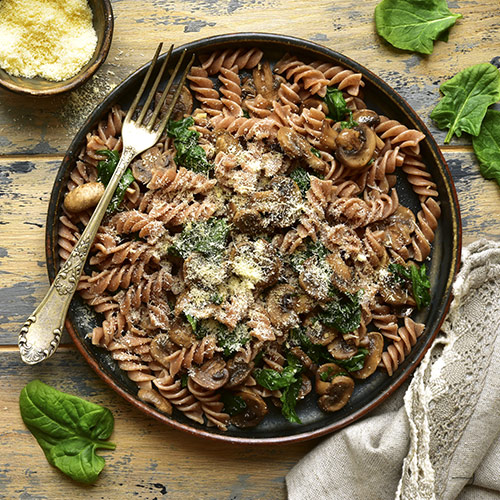
By increasing your intake of fiber, plant-based protein, B-vitamins, vitamin E and minerals such as magnesium and iron, whole grains provide more than their refined counterparts (think: white bread, traditional pasta, white rice). For this reason, one of the top recommendations made in the 2020-2025 USDA Dietary Guidelines is to make half your grains servings from the Grain Food Group come from whole grains.1
What Makes a Grain Whole Grain?
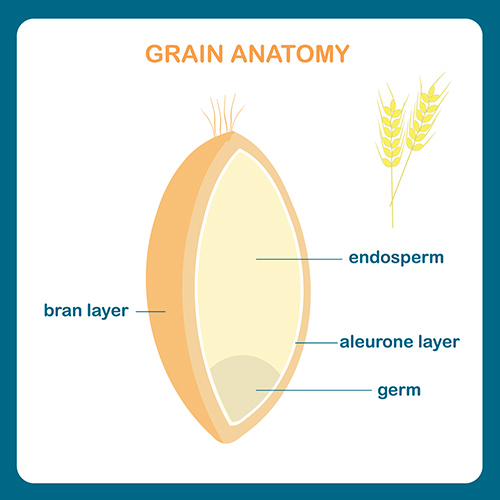
Whole grains outdo refined grains simply because their gifts from Mother Nature remain from field to plate. For whole grains, the three layers naturally found in a grain— germ, bran and endosperm— are still intact. These three layers are the reason whole grains offer their nutritional benefits.
Tips for Switching to Whole Grain Foods.
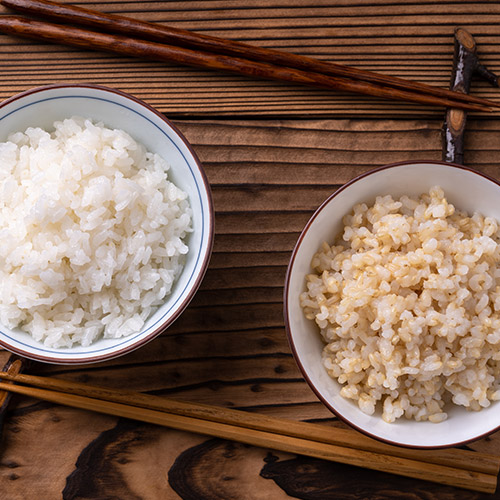
If you’re more of a refined grain connoisseur, taking steps to increase your intake of whole grains may feel like a feat. Luckily, food manufacturers have now mastered the art of offering great tasting whole grains…as well as taking steps to identify those they offer.
Shopping for whole grains requires a keen eye on the Ingredients List. Don’t let the simple color of something make you assume you’re looking at a whole grain. A great example of this is “honey wheat” bread. You may look at the Ingredients List of a brown bread called “honey wheat,” assuming it’s a whole grain, and learn it is made from refined wheat flour and added brown coloring from caramel or molasses.
When shopping for whole grain breads, cereals, granola bars, wraps, pita bread, crackers, pasta and the like, look for the word “whole” listed before the predominant flour or grain.
Shopping By the Whole Grain Stamp.
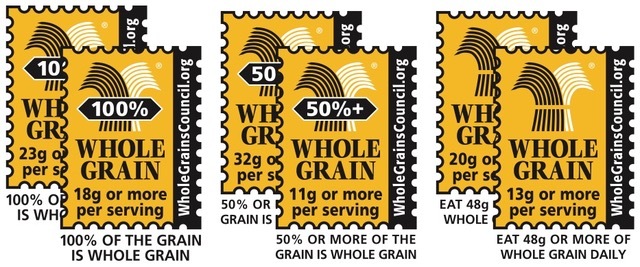
Oldways Whole Grains Council, www.wholegrainscouncil.org
For grain foods offering a mixture of ingredients, the Whole Grain Council’s Whole Grain stamps are especially helpful.
- 100% Whole Grain- All the product’s grain ingredients are whole grain and have at least a full serving (16 grams) whole grain per serving.
- 50%+ Whole Grain- Foods that have at least half of its grain ingredients coming from whole grains and at least half a serving of whole grains (or 8 grams) per serving.
- Basic Whole Grain- Food has at least half a serving of whole grains (8 grams) in addition to other ingredients such as refined grains. Note: The food item may contain more refined grains than whole grains.
It’s important to note some products containing large amounts of whole grains (23g, 37g, etc.) may have the 50%+ or Basic Whole Grain stamp if they also contain added bran, germ or refined flour.
What Counts as a Serving of Whole Grains?
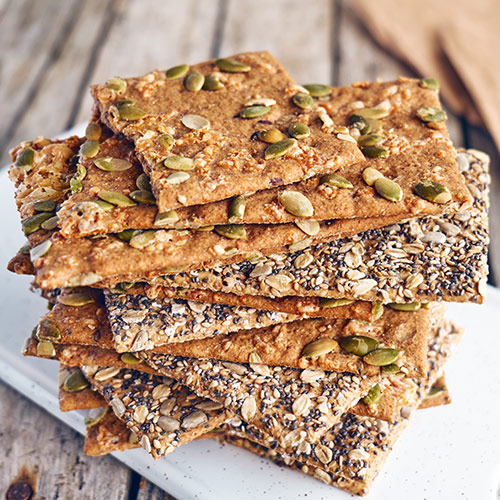
Although the Dietary Guidelines recommends 6,1-ounce equivalents of grains for a 2,000 calorie-meal plan, you can learn your recommended daily intake from the Grain Food Group at MyPlate.gov.
To reach your daily Grain Food Group goals with at least half being whole grains, learn what counts as a 1-ounce equivalent serving of whole grains:2,3
- 2-inch diameter whole grain bagel
- 1/2 cup cooked whole grain barley (not pearled)
- 1/2 cup cooked buckwheat
- 1 cup whole grain cereal
- 6 whole grain crackers
- 1/2 cup cooked einkorn
- 1/2 cup cooked whole grain farro
- 1/2 cup cooked Kamut®
- 1/2 cup millet
- 1/2 cup cooked, 1 packet instant and 1/3 cup dry oats
- 4 1/2-inch diameter whole grain pancake
- 1/2 cup cooked whole grain pasta
- 3 cups popcorn
- 1/2 cup cooked quinoa
- 1/2 cup cooked brown or wild rice
- 1/2 cup cooked sorghum
- 1/2 cup cooked spelt
- 1/2 cup cooked teff
- 6-inch diameter whole grain or corn tortilla
- 1/2 cup cooked wheat berries
Adding More Whole Grains to Your Meals.
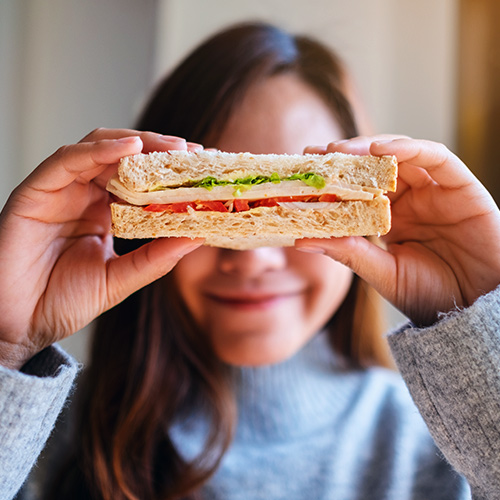
Making half your grain servings from the Grain Food Group come from whole grains takes some intention and planning, but it is completely doable. Making half your grains whole could be one change you find easiest of all to keep for the rest of your life.
Here are ways to incorporate more whole grains into the foods you eat:
- Switch sandwich bread to whole grain white (Yes, it exists!).
- Add brown rice, quinoa or wheat berries to meals in place of traditional white rice.
- Sprinkle wild rice, spelt, sorghum or teff onto leafy green salads.
- Choose whole grain pasta, especially when making casserole or soup.
- Fill your morning bowl with a blend of your typical breakfast cereal and a whole grain option. Slowly decrease the volume of your typical cereal while increasing the volume of the whole grain variety until you’re ready to make the leap to almost all (if not all) whole grain.
- Snack on whole grain crackers paired with nuts, nut butter or cheese.
- Whip up buckwheat pancakes for Sunday brunch.
- Wrap sandwiches with a whole grain flour or corn tortilla.
1 U.S. Department of Agriculture and U.S. Department of Health and Human Services. Dietary Guidelines for Americans, 2020-2025. 9th Edition. December 2020. Available at DietaryGuidelines.gov.
2 The Oldways Whole Grains Council. Definition of a whole grain. https://wholegrainscouncil.org/definition-whole-grain Accessed on 1/17/2023.
3 United States Department of Agriculture My Plate. What foods are in the grains group? https://www.myplate.gov/eat-healthy/grains. Accessed on 1/17/2023.
Published 1/23/2023


